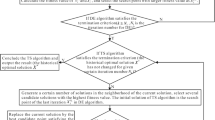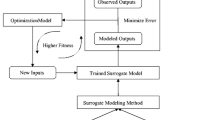Abstract
Measurements of contaminant concentrations inevitably contain noise because of accidental and systematic errors. However, groundwater contamination sources identification (GCSI) is highly dependent on the data measurements, which directly affect the accuracy of the identification results. Thus, in the present study, the wavelet hierarchical threshold denoising method was employed to denoise concentration measurements and the denoised measurements were then used for GCSI. A 0–1 mixed-integer nonlinear programming optimization model (0–1 MINLP) based on a kernel extreme learning machine (KELM) was applied to identify the location and release history of a contamination source. The results showed the following. (1) The wavelet hierarchical threshold denoising method was not very effective when applied to concentration measurements observed every 2 months (the number of measurements is small and relatively discrete) compared with those obtained every 2 days (the number of measurements is large and relatively continuous). (2) When the concentration measurements containing noise were employed for GCSI, the identifications results were further from the true values when the measurements contained more noise. The approximation of the identification results to the true values improved when the denoised concentration measurements were employed for GCSI. (3) The 0–1 MINLP based on the surrogate KELM model could simultaneously identify the location and release history of contamination sources, as well reducing the computational load and decreasing the calculation time by 96.5% when solving the 0–1 MINLP.









Similar content being viewed by others
Explore related subjects
Discover the latest articles and news from researchers in related subjects, suggested using machine learning.References
Atmadja J, Bagtzoglou AC (2001) State of the art report on mathematical methods for groundwater pollution source identification. Environ Forensic 2:205–214
Ayvaz MT (2010) A linked simulation–optimization model for solving the unknown groundwater pollution source identification problems. J Contam Hydrol 117(1–4):46–59. https://doi.org/10.1016/j.jconhyd.2010.06.004
Barzion AD, Tremblay-Darveau C, Yin M et al (2015) Denoising of contrast-enhanced ultrasound cine sequences based on a multiplicative model. IEEE Trans Biomed Eng 62(8):1969–1980
Chen C, Li W, Su H, Liu K (2014) Spectral-spatial classification of hyperspectral image based on kernel extreme learning machine. Remote Sens 6(6):5795–5814
Datta B, Chakrabarty D, Dhar A (2009) Simultaneous identification of unknown groundwater pollution sources and estimation of aquifer parameters. J Hydrol 376(1–2):48–57. https://doi.org/10.1016/j.jhydrol.2009.07.014
Ferrari RJ, Winsor R (2005) Digital radiographic image denoising via wavelet-based hidden Markov model estimation. J Digit Imaging 18(2):154–167
Guo JY, Lu WX, Yang QC et al (2018) The application of 0–1 mixed integer nonlinear programming optimization model based on a surrogate model to identify the groundwater pollution source. J Contam Hydrol 220:18–25
Gzyl G, Zanini A, Fraczek R et al (2014) Contaminant source and release history identification in groundwater: a multi-step approach. J Contam Hydrol 157:59–72
Huang GB, Zhu QY, Siew CK (2004) Extreme learning machine: a new learning scheme of feedforward neural networks. In neural networks. Proceedings. 2004 IEEE international joint conference on IEEE, vol 2, pp 985-990
Huang G, Huang GB, Song S et al (2015) Trends in extreme learning machines: a review. Neural Netw 61:32–48
Jiang X, Lu WX, Hou ZY, Lu W, Hou Z, Zhao H, Na J (2015) Ensemble of surrogates-based optimization for identifying an optimal surfactant-enhanced aquifer remediation strategy at heterogeneous DNAPL-contaminated sites. Comput Geosci 84(2015):37–45
Mahar PS, Datta B (2000) Identification of pollution sources in transient groundwater systems. Water Resour Manag 14(3):209–227
Michalak AM, Kitanidis PK (2003) A method for enforcing parameter nonnegativity in Bayesian inverse problems with an application to contaminant source identification. Water Resour Res 39(2)
Michalak AM, Kitanidis PK (2004) Estimation of historical groundwater contaminant distribution using the adjoint state method applied to geostatistical inverse modeling. Water Resour Res 40(8):W08302
Mirghani BY, Zechman EM, Ranjithan RS et al (2012) Enhanced simulation-optimization approach using surrogate modeling for solving inverse problems. Environ Forensic 13(4):348–363
Percival DB, Walden AT (2000) Wavelet methods for time series analysis. Cambridge University Press, Cambridge
Rajaee T, Jafari H (2018) Utilization of wgep and wdt models by wavelet denoising to predict water quality parameters in rivers. J Hydrol Eng 23(12):04018054
Rouis M, Ouafi A, Sbaa S (2019) Optimal level and order detection in wavelet decomposition for PCG signal denoising. Biomedizinische Technik/Biomedical Engineering 64(2):163–176
Shi Y, Zhao LJ, Tang J (2014) Recognition model based feature extraction and kernel extreme learning machine for high dimensional data. Adv Mater Res 875:2020–2024
Singh RM, Datta B, Jain A (2004) Identification of unknown groundwater pollution sources using artificial neural networks. J Water Resour Plan Manag 130(6):506–514
Skaggs TH, Kabala ZJ (1994) Recovering the release history of a groundwater contaminant. Water Resour Res 30(1):71–79
Sun AY, Painter SL, Wittmeyer GW (2006) A robust approach for iterative contaminant source location and release history recovery. J Contam Hydrol 88(3–4):181–196
Wong PK, Wong KI, Vong CM et al (2015) Modeling and optimization of biodiesel engine performance using kenel-based extreme learning machine and cuckoo search. Renew Energy 74:640–647
Woodbury AD, Ulrych TJ (1996) Minimum relative entropy inversion: theory and application to recovering the release history of a groundwater contaminant. Water Resour Res 32(9):2671–2681
Wu S, Wang YY, Cheng SJ (2013) Extreme learning machine based wind speed estimation and sensorless control for wind turbine power generation system. Neurocomputing 102:163–175
Xing ZX, Qu RZ, Zhao Y et al (2019) Identifying the release history of a groundwater contaminant source based on an ensemble surrogate model. J Hydrol 572:501–516
Xu Y, Dai YY, Dong ZY, Dai Y, Dong ZY, Zhang R, Meng K (2013) Extreme learning machine-based predictor forreal-time frequency stability assessment of electric power systems. Neural Comput & Applic 22(3–4):501–508
Zhao Y, Lu WX, Xiao CN (2016) A Kriging surrogate model coupled in simulation–optimization approach for identifying release history of groundwater sources. J Contam Hydrol 185–186:51–60
Zhao Y, Fu Q, Lu WX, Lu W, Yi J, Chu H (2019) Wavelet denoising and cubic spline interpolation for observation data in groundwater pollution source identification problems. Water Supply 19(5):1454–1462
Acknowledgments
This study was supported by the National Nature Science Foundation of China (No. 41672232) and Jilin Province Science and Technology Development Project (No. 20170101066JC). Special thanks are given to the journal editors and anonymous reviewers for their valuable comments and suggested revisions.
Author information
Authors and Affiliations
Corresponding author
Additional information
Responsible Editor: Marcus Schulz
Publisher’s note
Springer Nature remains neutral with regard to jurisdictional claims in published maps and institutional affiliations.
Rights and permissions
About this article
Cite this article
Li, J., Lu, W., Wang, H. et al. Groundwater contamination sources identification based on kernel extreme learning machine and its effect due to wavelet denoising technique. Environ Sci Pollut Res 27, 34107–34120 (2020). https://doi.org/10.1007/s11356-020-08996-7
Received:
Accepted:
Published:
Issue Date:
DOI: https://doi.org/10.1007/s11356-020-08996-7




